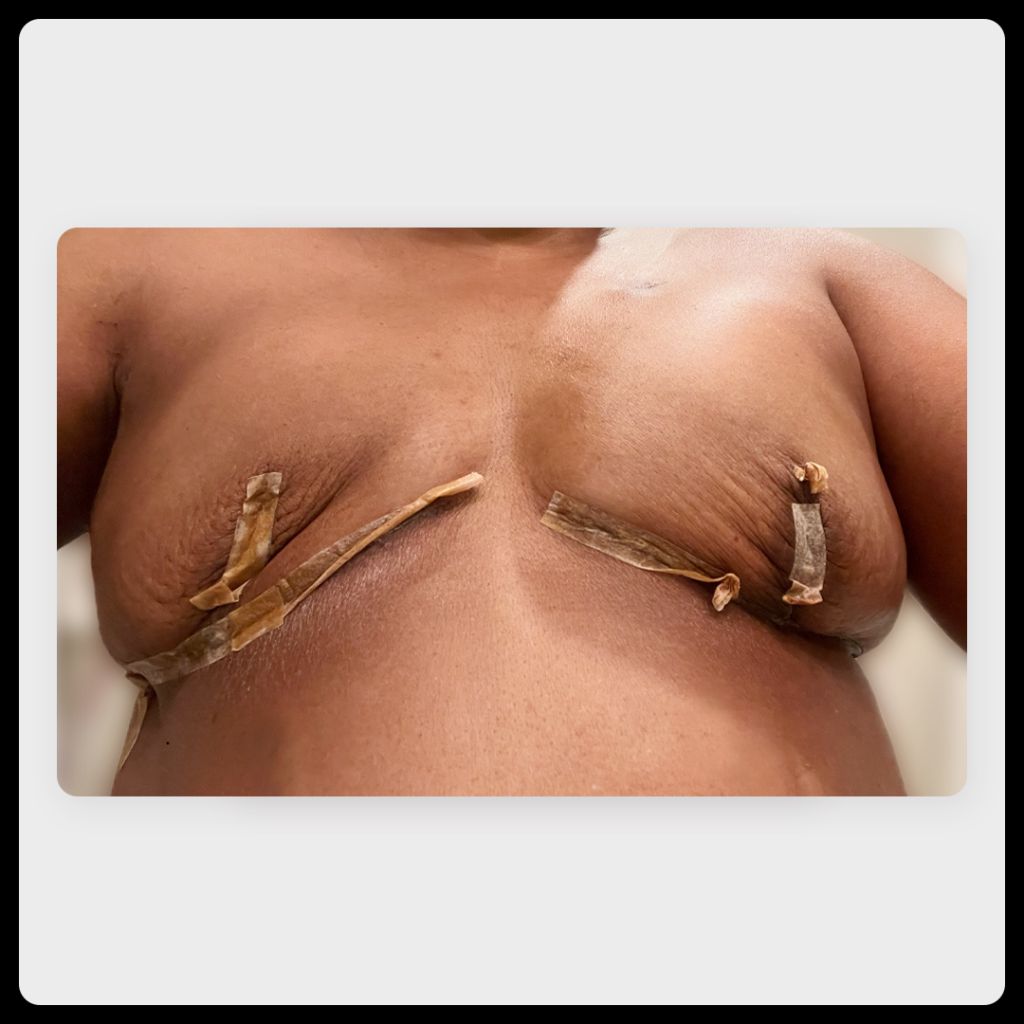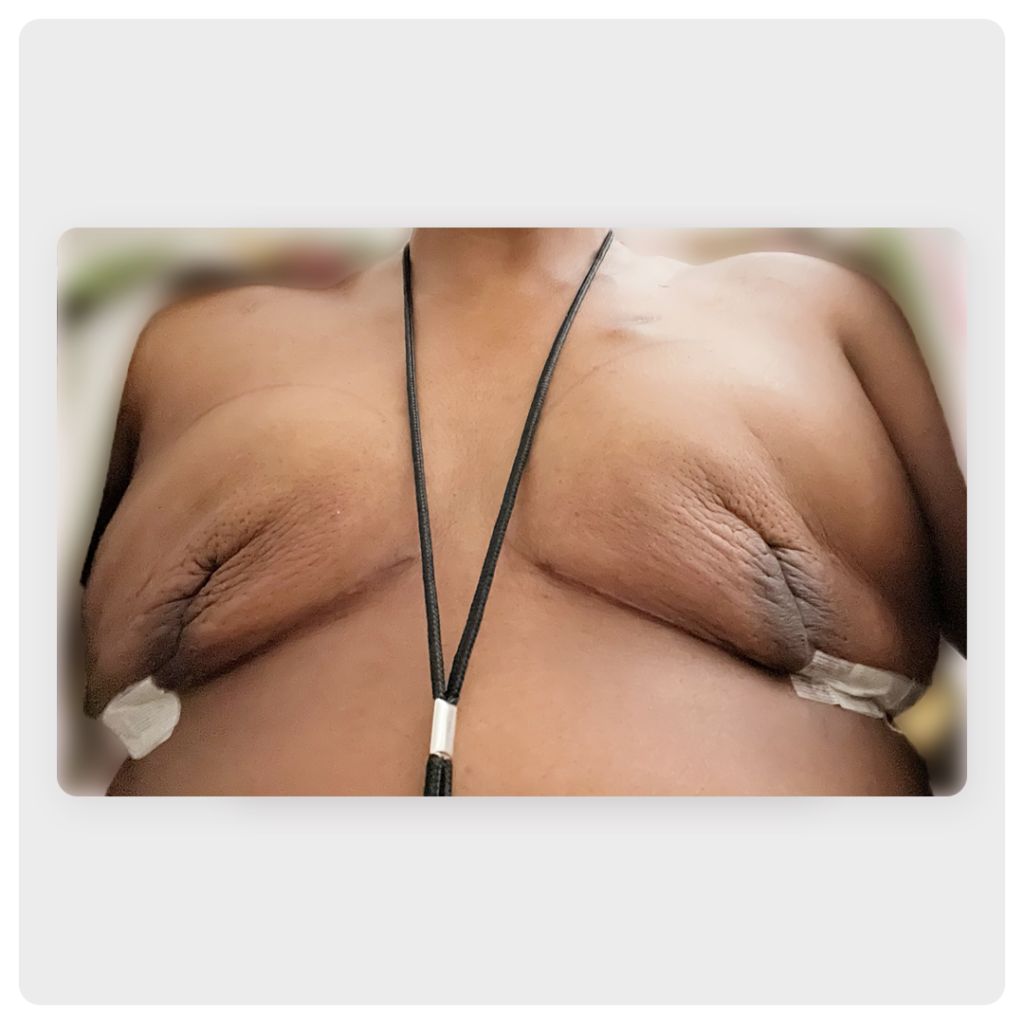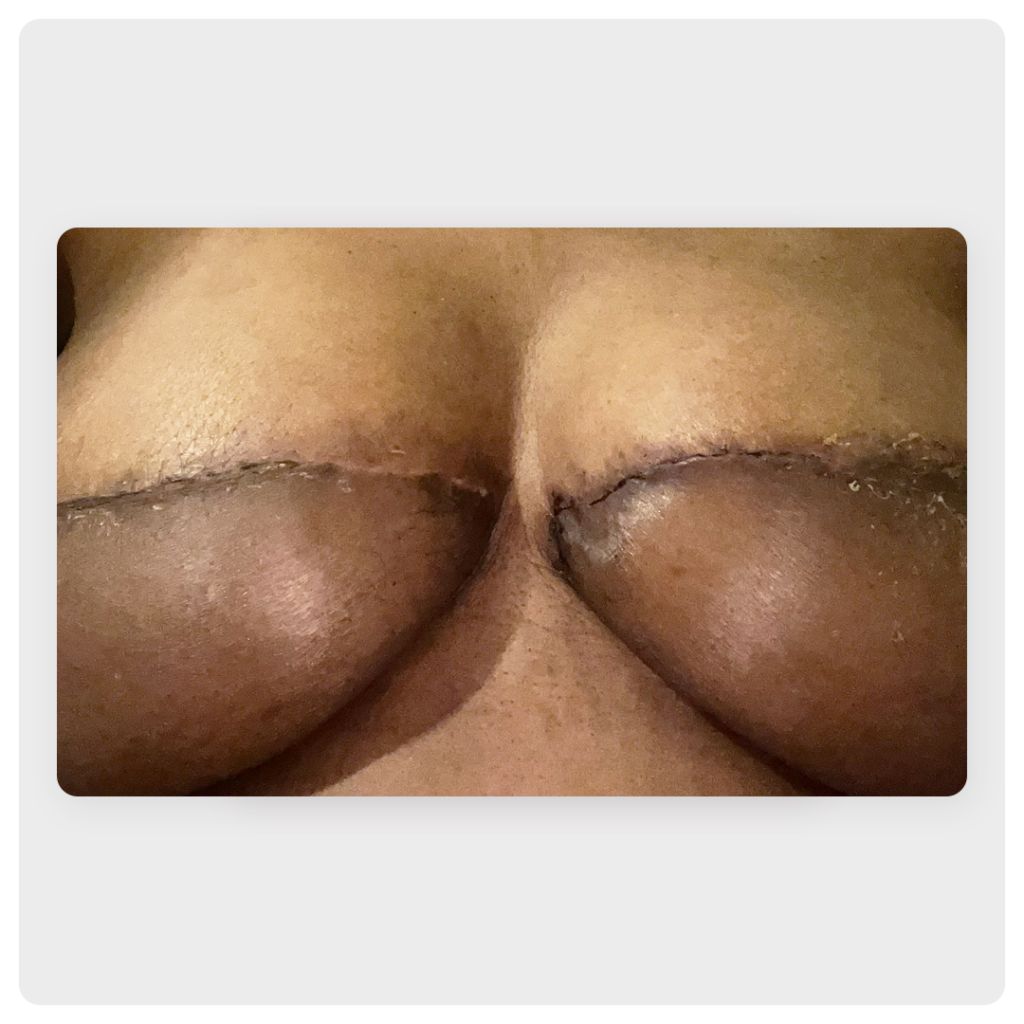Hindsight Is 20/20: Double Mastectomy and DIEP Flap Reconstruction without Nipple
March 28, 2024
Content created for the Bezzy community and sponsored by our partners. Learn More

Illustration by Brittany England
I was told she’d have one surgery, and the tissue expanders were never explained. In hindsight, I would’ve preferred flat closure.
- Procedure: double mastectomy, reconstruction without nipple
- Reconstruction immediately post-mastectomy: no
- Year of procedure: 2023
- Age: 55
- Ethnicity: Black/African American
This article contains graphic, intimate images of a postsurgery body. The photos have been generously shared by a breast cancer survivor so that others can benefit from uncensored visual information that may help them make important surgical decisions for themselves.
I had fibrocystic breast tissue at sixteen, so I always had cysts and things like that in my breast tissue.
Then in 2022, I had a huge hemangioma, or growth made up of extra blood vessels. It seemed to be changing shape and location. There was a lump you could see and feel. I thought it might be fibroadenoma — a benign, solid tumor.
When I got a mammogram and ultrasound, the radiologist was very rude. She said, “Look at all this junk in here.” Before she left the room, she told me very matter-of-factly that I had cancer, which is not something a radiologist should be doing.
As an X-ray technician and allied health professional, I was shocked. I treat everyone equally, and the treatment I received was not the same. That was hard to digest.


Getting diagnosed and starting treatment
I didn’t feel like I had cancer. I kept telling myself I hadn’t had a biopsy yet. As a tech, I’ve seen a lot of horrible-looking lesions that turned out not to be cancerous.
I had my first biopsy in April and a second at the end of the month. On May 12, the surgeon called me and told me I had aggressive invasive ductal carcinoma (IDC).
They started me on chemo and targeted HER2+ treatment from July through the end of September. The chemo was effective, and the tumor shrunk from 11 to 7 cm.
Then it was time for surgery. I wanted the surgeon to take both breasts as a preventive measure.

Not feeling properly cared for
My plastic surgeon kept going out of town and leaving me with his personal assistant. They didn’t explain much to me, but they gave me a book showing how the tissue expanders go in along with the implants.
I thought it was going to happen all at once.
Right before my surgery, I had a terrible experience. They put me in a room next to a woman who was clearly sick and coughing constantly. I was very nervous because of COVID-19.
The nurse even switched the IVs from the sick woman’s pod to mine. When she inserted it, it was really painful. When I told the staff, they told the nurse to give me some lidocaine, a local anesthetic.
This first IV turned out to be a mistake on the nurse’s part, and they had to insert another, larger one during surgery to accommodate the right amount of anesthesia.
Then the respiratory therapist insisted I’m not allergic to latex, even though I know I have a latex allergy.
When the surgeon showed up, I told her I had been about to leave.
After surgery, I woke up with a compression band around my chest, so I couldn’t tell how the surgery went.
They sent me home with an electronic unit that helps with wound care and drainage, known as a wound vac or vacuum-assisted wound closure (VAC). Mine was broken and just kept going off. I had to wear it the whole weekend until I could see the plastic surgeon on Monday.
Then things started to go downhill even more.
More like this:
- These Boobs Are All Me: Double Mastectomy and DIEP-Flap without Nipple
- Finally Happy: Double Mastectomy and Reconstruction with Nipple Tattoo
- Second Time’s The Charm: Double Mastectomy and Reconstruction without Nipple
- Feeling Unbalanced: Double Mastectomy with DIEP Flap, Implants, and Nipple Reconstruction
Getting answers about my pain
When I went in for follow-up appointments, they drained the fluid in a non-sterile situation.
They said I was healing well on the outside, but they didn’t fill my tissue expanders because I was continually in pain. I had the fluid buildup drained three times in person in addition to the drains that had been placed in my body.
When I finally saw a new plastic surgeon, she sent samples to the lab.
She asked me, “Are you sure your tissue expanders haven’t been filled?” That’s how much fluid buildup there was.
I told her I wouldn’t allow anyone to fill them because I was in so much pain. I couldn’t lift up my arms or wipe when I went to the bathroom.
Then I started having chest pain. I thought, “After all that, now I’m having a heart attack.” I went to the ER, and they found I had a hospital-born bacteria in my chest called Klebsiella oxytoca.
It took many doctors a long time to figure it out until I was finally put on a powerful antibiotic.
Once the fluid cleared, I had the tissue expanders removed.
After that surgery, I woke up to find my knee was swollen. When I started asking questions, another merry-go-round of doctors didn’t provide any answers. Or they had rude, dismissive replies.
One doctor told me that my knee was hurting because I was arthritic, overweight, and old.
I knew something had happened. Finally, an MRI found a tear in my medial meniscus.
I’d never felt nervous about interacting with healthcare professionals until then. Now I was having panic attacks. I didn’t trust them anymore.
My hypothesis is my knee was injured during surgery. As a tech, I used to go to surgery suites all the time. They teach you how to lift a person to keep them in alignment when you move them to the bed. I’ve seen a person’s foot get caught underneath the bed or something similar.
I suspect this is what happened to me. It’s possible there are a lot of injuries like that that medical staff dismiss. I’m currently looking for a lawyer.
I paid out of pocket for stem cells and protein-rich plasma (PRP) to correct the knee injury, because insurance doesn’t pay for things like that.

Another round of surgery
I finally had my DIEP flap surgery in July of 2023, almost a year after my mastectomy. I went to a destination surgery center and had a very pleasant experience there.
I was cleaning and taking care of my wounds while recovering in a hotel, and my pelvic incision from DIEP flap surgery opened. I had to go back in August and September.
My son was wonderful during this time. He fed me, took care of me, helped me with my drains, and took me to appointments. He even helped me wash my back in the bathtub. I tried to be modest because it was difficult for both of us.
Eventually, I had to be hospitalized because my hemoglobin was so low from bleeding that I had to have a transfusion. They put in a drain and put me on two different IV antibiotics.
My last surgery was on November 16th, 2023. They made sure that my wounds were clear and cleaned up, and they took out some scar tissue. Then I had my last immunotherapy in September 2023.
After that, the medical team tried to get me to do radiation therapy, but I was skeptical because I heard other women had bad experiences with lung scarring. My doctor said that was a possibility, so I opted not to get it.

What I want people to know
I didn’t think I’d need three surgeries or that there would be so many surgical complications. I’m not sure what I’m supposed to do about the pain and numbness I still have.
If I’d known about the tissue expanders and how difficult they would be, I would’ve just had my mastectomy and been done with it. They caused me a lot of mental anguish, medical trauma, and pain.
I now have breasts, but hindsight is 20/20. After what I went through, a flat closure would have been preferred.
Bezzy BC and Young Survival Coalition are partnering to create What It Looks Like, a series showcasing photographs of different breast reconstruction choices on bodies of all shapes, sizes, and colors.
We’re spotlighting breast cancer survivors’ reconstruction decisions and stories so that other women facing mastectomy surgery can see and hear about many different real-life outcomes.
If you’re a survivor who’d like to share your reconstruction (or flat closure) images and story, we’d love to hear from you. Just have your photos ready and fill out this submission form.
Images and stories will be anonymously published on BezzyBC.com.
Medically reviewed on June 03, 2024


Like the story? React, bookmark, or share below:
Have thoughts or suggestions about this article? Email us at article-feedback@bezzy.com.